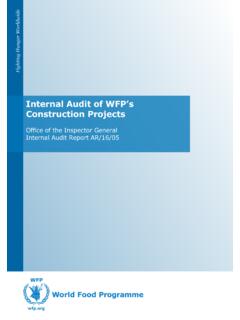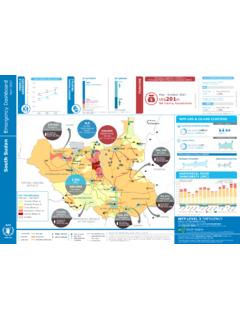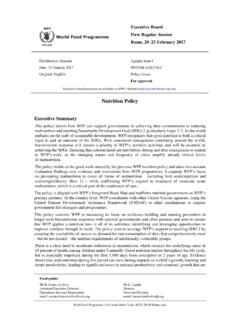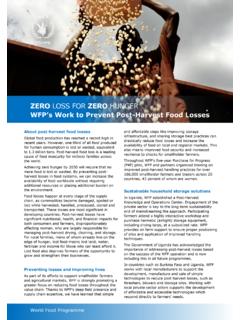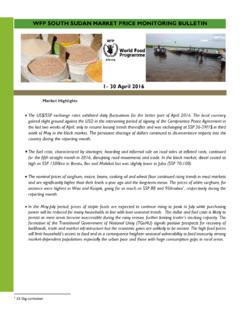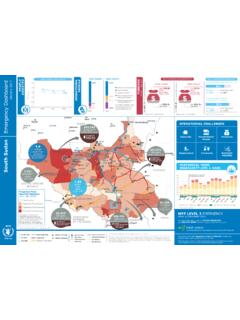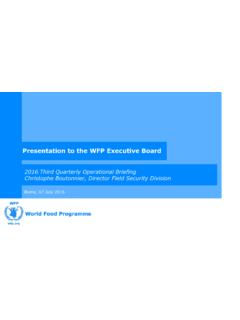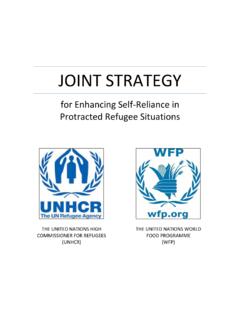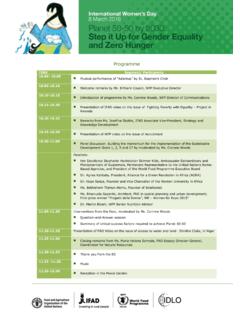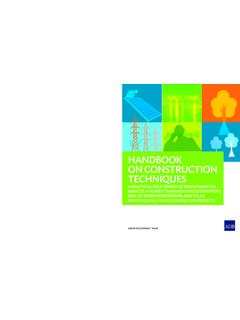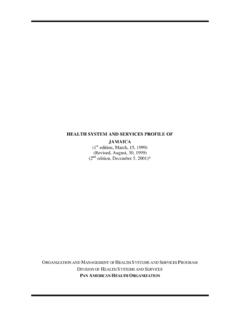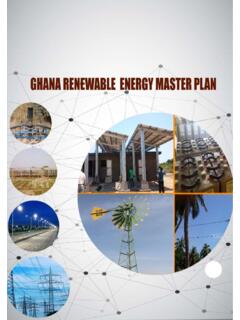Transcription of Part 3: Community-based Participatory Planning
1 Fighting Hunger Worldwide A WFP approach to operationalise resilience Part 3: Community-based Participatory Planning February 2014. A WFP approach to operationalise resilience Part 3: Community-based Participatory Planning What is CBPP? A tool to scale-up resilience Community-based Participatory Overall, the CBPP links people Planning (CBPP) is a practical to their landscapes and provides and easy-to-use Planning tool for the entry point for scaling up vulnerable communities, government resilience-building activities extension staff and cooperating through assets creation and partners. It is a two- to five-day field complementary partners' efforts. exercise used to develop a three-year For example, Food assistance programme plan.
2 (through food, cash or voucher transfers) for assets (FFA) can Through CBPP, food-insecure restore access to food through communities are placed in the the rehabilitation of degraded driver's seat of Planning , while lands, feeder roads and market contributing to their own resilience- infrastructure, and build disaster building efforts and development. resilience. WFP/Volli Carucci/Ethiopia Community-based Participatory Planning (CBPP) in action Ethiopia WFP/Volli Carucci/Haiti Haiti Now we can plan for resilience building. WFP and Government field staff . A tool that empowers the most address and reduce women's vulnerable hardship. CBPP is a community exercise CBPP fosters dialogue and new ideas aimed at addressing real community on how to tackle complex problems.
3 Problems and assisting them to As a result, it is a key tool able find their own solutions. CBPP is to encourage innovation and conducted together by communities, strengthen community cohesion. partners and local government staff The CBPP also includes benchmarks who discuss and agree on priority to monitor and evaluate results. activities to significantly improve the food security of the poorest and most vulnerable households. A tool that makes resilience cost effective Each CBPP is a commitment to address gender inequality. CBPP Communities using CBPP have contributes to empowering the most greater ownership over the vulnerable, and women in particular, programmes, and hence build better through their equal representation quality assets, and contribute to their in decision making and the selection creation and maintenance using their of activities .
4 CBPP also aims to own efforts. Part 3: Community-based Participatory Planning 1. CBPP ensures value for money as that takes to scale more structured activities accepted by the community and complementary actions from are maintained and often replicated. a number of partners ( FFA. from WFP, livestock vaccinations Clustering CBPPs provide an and improved seeds from FAO, and integrated intervention or treatment' agricultural credit from IFAD, etc.). unit to act as a major platform How does CBPP contribute It places people and partners at the to WFP's resilience centre of Planning , using converging approach? analyses, consultations, and consensus- building on actions required at three CBPP is central to WFP's Three-pronged different levels.
5 Approach to resilience building, that strengthens the design, Planning The Three-pronged approach contains and implementation of longer-term, new and innovative programming resilience-building programmes, tools and frameworks to strengthen developed in partnership and aligned to the identification and delivery of national and local priorities. programmes. 1. NATIONAL LEVEL: INTEGRATED CONTEXT ANALYSIS (ICA). The bigger picture : An integrated context analysis that combines historical trends of food security, nutrition, and shocks with other information such as land degradation, roads, markets, etc., to identify priority areas of intervention and appropriate programme strategies. 3. LOCAL A WFP's 2.
6 SUB-NATIONAL. LEVEL: LEVEL: SEASONAL. community . Three-pronged LIVELIHOOD. BASED Participatory approach to PROGRAMMING (SLP). Planning (CBPP) resilience building Getting better at From the bottom up : coordination A community level and partnerships : Participatory exercise to identify A consultative process needs and tailor programme to design an integrated responses to local requirements multi-year, multi-sectorial by ensuring prioritisation and operational plan using ownership by communities. seasonal and gender lenses. 2. What is the purpose of a Prioritizes key actions needed to CBPP? reduce disaster risk and build resilience against shocks. For example, building Five functions: flood protection dikes, raising grounds for feeder roads and homesteads, Links short- and long-term multi- stabilizing steep degraded slopes with sectorial interventions to tackle terracing, and repairing damaged the underlying causes of food irrigation schemes.
7 Insecurity and shocks. For example, complementary programmes to address Provides a local level tool for partners land degradation, a major cause of to complement food assistance by reduced production and food insecurity, identifying a package of activities that also multiplies the impacts of natural better support vulnerable groups, and shocks such as droughts and floods, women in particular. and it exacerbates local conflicts over scarce natural resources. CBPP links Empowers women and marginalized FFA to other WFP activities such as groups by including them in discussing, nutrition and school feeding, and to selecting, implementing, and benefitting other partner efforts such as farmer from programmes that reduce their field-schools, microcredit and income environmental, social and economic generation programmes.
8 Hardships within a community . WFP/Siddiqul Islam Khan/Bangladesh community Participatory Planning and mapping in 2012 Bangladesh Part 3: Community-based Participatory Planning 3. WFP/Raffaella Policastro/South Sudan Water pond construction in South Sudan. This activity was identified as a priority through the CBPP in 2013. For example, through activities that: are difficult to restore ( arid reduce time for wood or water collection lands, sloping terrains, etc.), where and improve water quality; improve resources are depleted, access to food access to land by reclaiming marginal is problematic, and where the effects areas; increase access to fodder, wood of shocks are compounded by fragile products and crops around homesteads livelihoods and climate variability.
9 Using improved irrigation ( drip) In Kenya and Ethiopia for example, methods; and provide skills training. technical standards adopted for FFA. were designed to maximize water Enables the building and maintaining harvesting and reduce soil erosion, of quality assets. CBPP sets the which led to replenished water tables, construction specifications and increased irrigated plots, and re- community maintenance protocols vegetation of bare lands, all of which at the highest possible standards. have significantly reduced the impact of This is essential, especially in droughts. environments that by their nature 4. How does CBPP work? 3. Select and design activities FFA and other activities needed to Five steps: solve the problem are identified.
10 Technical design aspects, such as 1. Describe the community and standards and work norms, transfer their surrounding environment modalities, and environmental This includes defining the safeguards are determined, tailored geographical boundaries of the to context, and finalized. community and the land use within them, the prevailing agro- 4. Build partnerships ecological and sub-watershed Complementary activities across systems, degradation features, sectors that reinforce each other such as ravines and gullies, areas of are identified, sequenced, and greatest shock risks such as flooding aligned with partners. For example, and landslides, and community programmes for livestock can infrastructure, such as homes, include water ponds, vaccination and water points, and schools, etc.
